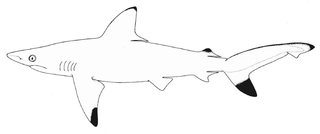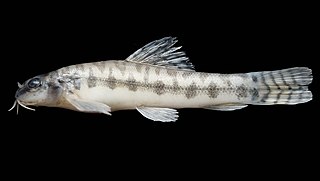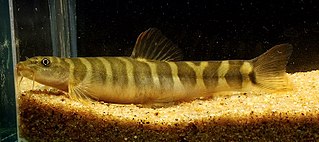
A dorsal fin is a fin located on the back of most marine and freshwater vertebrates within various taxa of the animal kingdom. Many species of animals possessing dorsal fins are not particularly closely related to each other, though through convergent evolution they have independently evolved external superficial fish-like body plans adapted to their marine environments, including most numerously fish, but also mammals such as cetaceans, and even extinct ancient marine reptiles such as various known species of ichthyosaurs. Most species have only one dorsal fin, but some have two or three.

The Pondicherry shark is an extremely rare species of requiem shark, in the family Carcharhinidae. A small and stocky gray shark, it grows not much longer than 1 m (3.3 ft) and has a fairly long, pointed snout. This species can be identified by the shape of its upper teeth, which are strongly serrated near the base and smooth-edged near the tip, and by its first dorsal fin, which is large with a long free rear tip. Furthermore, this shark has prominent black tips on its pectoral fins, second dorsal fin, and caudal fin lower lobe.
Acanthocobitis is a genus of freshwater ray-finned fish of the stone loach family, Nemacheilidae. Recent work has suggested that the genus be split into two with the former subgenus Paracanthocobitis being raised to a full species, leaving just the type species, Acanthocobitis pavonacea, in the current genus.

The vadigo, Campogramma glaycos, is a species of medium-sized coastal marine fish in the jack family, Carangidae. The species is distributed throughout the eastern Atlantic Ocean from the British Isles in the north to Senegal in the south, also entering the western Mediterranean Sea. The vadigo is similar in form to both the leatherjacks and the queenfish, but can be distinguished by its scaleless chest and a broad, rounded upper jaw. It is a predatory fish, preying mostly on smaller schooling fishes. The species was initially classified under the genus Centronotus before being transferred to its own monotypic genus of Campogramma. The vadigo is of minor commercial importance throughout its range, and is also considered to be a game fish.

The shadow trevally, also known as the shadow kingfish, twothread trevally or Aldabra trevally, is a species of inshore marine fish in the jack family Carangidae. The species is patchily distributed throughout the tropical and subtropical waters of the Indian and west Pacific Oceans, from South Africa in the west to Japan and Samoa in the east, reaching as far south as Indonesia and New Caledonia. It is most easily distinguished from similar species by as series of dark rectangular blotches under the second dorsal fin, giving a 'shadowed' appearance, from which its common name is derived. The shadow trevally is a reasonably large fish, growing to 85 cm in length and at least 2.6 kg in weight. It inhabits shallow coastal waters, including reefs, bays, and estuaries, where it takes small fish and benthic crustaceans as prey. Nothing is known of the species' ecology and reproductive biology. It is of little importance to fisheries, and is occasionally taken by bottom trawls and other artisanal fishing gear.

Paracanthocobitis is a genus of freshwater ray-finned fishes belonging to the family Nemacheilidae, the stone loaches. This genus is known from the Indus basin in Pakistan to the Mekong basin of Cambodia and Laos The type species is Paracanthocobitis zonalternans. Some authorities treat this as a subgenus of Acanthocobitis

Paracanthocobitis mooreh also known as the Maharashtra zipper loach is a species of ray-finned fish in the genus Paracanthocobitis. This species is found in the Godavari, Krishna, and Kaveri basins of western and southern India.
Paracanthocobitis pictilis, also known as the Ataran zipper loach, is a species of ray-finned fish in the genus Paracanthocobitis. It is native to Myanmar and Thailand. It was described to science in 2012.

Paracanthocobitis urophthalma, also known as the banded mountain zipper loach, is a species of ray-finned fish in the genus Paracanthocobitis. This species is endemic to southwestern Sri Lanka.

Paracanthocobitis zonalternans also known as the dwarf zipper loach is a species of ray-finned fish in the genus Paracanthocobitis. This species is known from Bangladesh, Myanmar, Thailand, and peninsular Malaysia. It is found in the Brahmaputra, Meghna, Irrawaddy, Sittang, Salween, Maeklong, and drainages in peninsular Thailand and Malaysia. The range extends from northern Myanmar to peninsular Malaysia. It is not known from the Chao Phraya basin.
Paracanthocobitis abutwebi also known as the hillstream zipper loach is a species of ray-finned fish in the genus Paracanthocobitis. This species is known from the Karnaphuli, Meghna, and lower Brahmaputra and Ganges river drainages of Bangladesh.
Paracanthocobitis adelaideae also known as the checkerboard zipper loach is a species of ray-finned fish in the genus Paracanthocobitis. This species is known from the Irrawaddy basin of northern Myanmar.
Paracanthocobitis canicula also known as the houndstooth zipper loach is a species of ray-finned fish in the genus Paracanthocobitis. This species is known from the lower Mekong basin of Cambodia.
Paracanthocobitis linypha also known as the sewing needle zipper loach is a species of ray-finned fish in the genus Paracanthocobitis. This species is known from the Irrawaddy and Sittang basins in Myanmar.

Paracanthocobitis botia also known as the mottled zipper loach is a species of ray-finned fish in the genus Paracanthocobitis. This species is known from the mainstem, and possibly tributaries of the Brahmaputra River, in Assam, India.
Paracanthocobitis mackenziei also known as the robust zipper loach is a species of ray-finned fish in the genus Paracanthocobitis. This species is the most widely distributed species of Paracanthocobitis and is known from the Ganges River basin of Nepal and India, the Meghna River basin in Bangladesh, the Mahanadi River basin in eastern India, and the upper Indus River basin of northern India and eastern Pakistan. Fishbase treats P. (A). mackenziei under Nemachilus mackenziei as a synonym of Acnthocobitis botia.
Paracanthocobitis mandalayensis also known as the Mandalay zipper loach is a species of ray-finned fish in the genus Paracanthocobitis. This species is known from the Irrawaddy drainage of northeastern Myanmar, Sittang basin of southern Myanmar, and the Wang and Ping rivers in the Chao Phraya River basin of northwestern Thailand.
Paracanthocobitis rubidipinnis also known as the cherryfin zipper loach is a species of ray-finned fish in the genus Paracanthocobitis. This species is known from the Irrawaddy basin in Myanmar.
Paracanthocobitis aurea also known as the barred zipper loach is a species of ray-finned fish in the genus Paracanthocobitis. This species is known only from the type locality, the Narmada River at Jabalpur, state of Madhya Pradesh, India.
Schistura madhavai, is a species of ray-finned fish in the genus Schistura, newly distributed from Sri Lanka. It is the second species of Schistura stone loach described from Sri Lanka, the other being the widely distributed native species Schistura notostigma.






